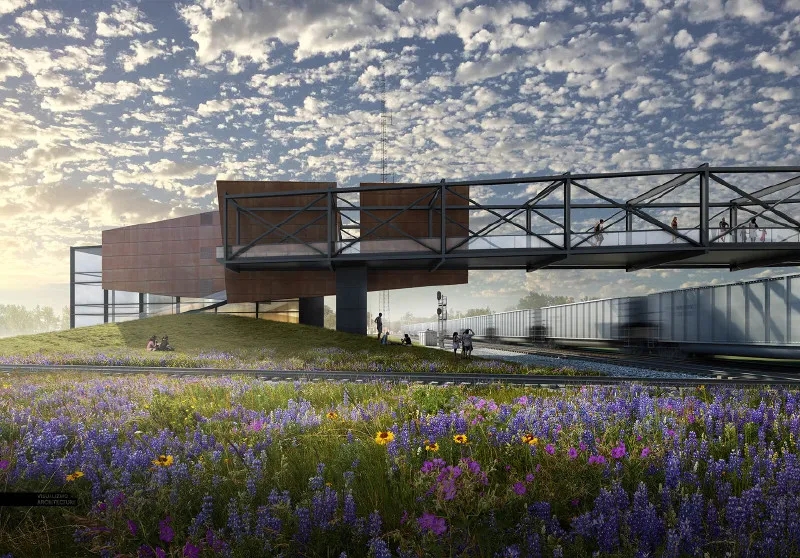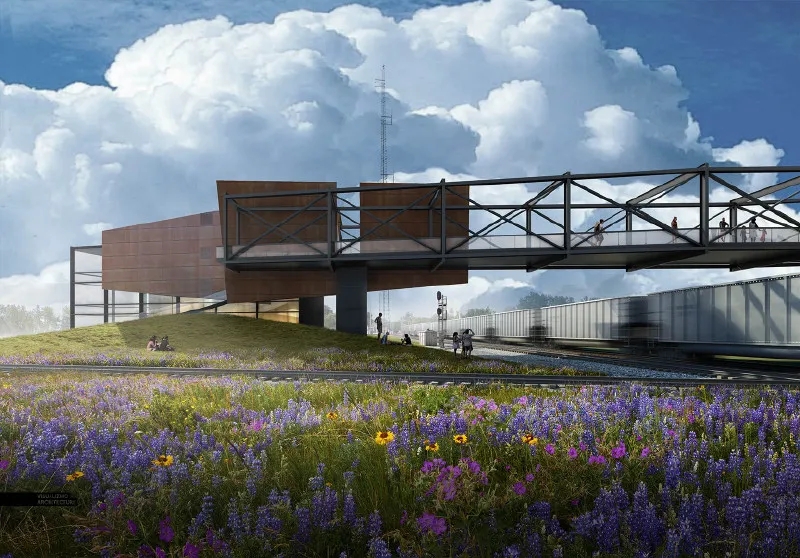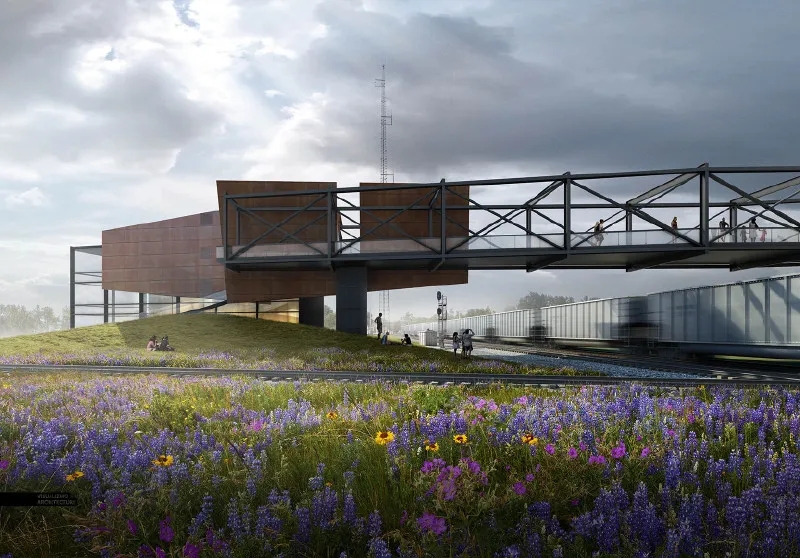从如何分辨场景需要什么样的环境,如何选择合适的,都有新的看法,所以分享给大家看看。接下来展示的要点希望可以带来启发,当然在实际情况中总会出现不一样的限制,还是一句话,设计靠感觉,灵活应用才是关键!
(因为是翻译,可能会有文字出入,下面有英文版本可以具体分析哦)
在大多数情况下,天空可以成就或破坏一个建筑插图。这也是我看到很多人在渲染中忽略或只花了几分钟的地方。问题是,一个好的天空会为图像设置整个基调。
正因为如此,这是我进入Photoshop后的首要任务。我花了不少时间在网上梳理图片,以找到最适合我的场景的图片。通过下面这些不同的图片,你会看到从仅仅改变天空到情绪和色调的转变。
在寻找完美的天空时,我有一些想法可以参考。应该指出的是,这些是指导方针。在架构可视化中,有许多不同的场景和情况可能不适用这些技巧。然而,我发现这种情况很少见,所以我几乎在我创作的每一张图片中都遵循了这些想法。
1.避免饱和度过高

过度饱和是经常碰到的一个问题。在网上看到的许多天空图像都有这个问题,因为天空被放大了,变得更加引人注目,吸引了观众的注意力。然而,过多的天空色彩饱和度会压倒建筑和地面的色彩,破坏插图的层次结构。为了解决这个问题,我进入“图像>调整>色相饱和度”,我移动“饱和度”滑块到左边来移除一些颜色
2.避免不自然的天空颜色
3.避免云朵占用太多

尽管你可能喜欢云,但过多的云会影响图像。简单地说,他们把所有的注意力从建筑上转移了。然而,在分散注意力和引人注目之间有一条微妙的界限。我倾向于喜欢多云的天空,但是我会通过降低颜色饱和度和淡化细节来稀释图像,这样纹理会更柔和。一个简单的方法是通过寻找一个没有云彩的天空,只有颜色,并设置它为基础天空。然后选择多云的天空,将这一层设置在刚刚着色的天空的顶部,并降低不透明度,使云读起来更轻
4.光源的错误方向
5. 正确的透视关系

这个想法是重要还是不重要取决于观点。然而,如果天空显示了正确的透视,那么显示深度的场景读起来会更好。在上面的例子中,云几乎没有透视,这意味着当它们向远处退去,接近地平线时,云的规模不会改变,这使得背景看起来更加平坦。
6.元素简单点
最终效果

我最终选择的天空是一个多云的有蓝色口袋的天空。这使得我可以突出从左边来的阳光,并给整个图像一个戏剧性的由亮到暗的渐变。我使用技巧#3中描述的类似过程组合了两个不同的云图像。我找了一个没有云彩,颜色很好的天空,然后把它和多云的天空结合起来。通过调整多云天空的不透明度,我能够在颜色和柔软度上达到良好的平衡。
处理完天空后,我就用颜色叠加放大了暖色调和冷色调,并在图像的基础上增加了更多的阴影。所有这些动作都有助于将观众的注意力从图像左侧移开,然后慢慢移到右侧,越过桥,移到右侧的火车上,模仿行人走过的路线。这样,我使用了从天空开始的光线来帮助讲述这个项目的故事。
原文
I can’t believe that I have not written a post about skies yet on this blog. In most cases, a sky can make or break an architecture illustration. It’s also something that I see a lot of people overlook or only spend a few minutes on in their renderings. The thing is, a good sky sets the entire mood of an image. Because of this, it’s my first priority as soon as I get into Photoshop. I spend quite a bit of time combing through images online to find the perfect one for my scene. With the different images below, you will see how much the mood and tone shift from just changing out the sky.
I have put together some ideas to think about when looking for that perfect sky. It should be noted that these are guidelines. There are many of different scenarios and situations in architecture visualization in which these tips may not apply. However, I have found that to be rare and I follow these ideas in almost every image that I create.
1. Avoid Oversaturated Color
Oversaturation is an issue I see often. Many of the sky images that I find online have this problem because the sky has been enhanced or amplified to be more dramatic and catch viewers attention. However, too much color saturation in the sky will overpower the colors in the architecture and ground plane ruining the hierarchy of the illustration. To fix this, I go into “Image>Adjustments>Hue Saturation” and I move the “Saturation” slider to the left to remove some of the color.
2.Avoid Awkward or Unnatural Colors
Unnatural color brings with it similar issues as oversaturation. Unnatural sky color can throw the whole image off from the start making it difficult to pull off a successful composition. Not only that, it creates a “Photoshopped” look instead of looking harmonious with the architecture and ground plane. Due to the many gradients and color tones, I prefer just finding another sky vs. trying to alter or fix the unnatural colors. However, if I really like the cloud forms or texture of the image, I sometimes will desaturate the color, and then use the color of a different sky overlaid on top.
3.Minimize Overly Busy Skies
As much as you may like clouds, too many will hurt the reading of the image. Simply put, they take all of the attention away from the architecture. However, there is a fine line between distracting and dramatic. I tend to like cloudy skies, but I will dilute the image by desaturating the color and fading out the detail so that the texture is softer. An easy way to fade the detail is by finding a sky with no clouds, just color, and setting that as the base sky. Then take the cloudy sky, set that layer on top of the just-color sky, and lower the opacity so that the clouds read much lighter.
4.Wrong Sun Direction
This is one of those situations where you look at an image, and something seems off, but it is not clear what is wrong. However, once a light source issue gets corrected, the image reads dramatically better. This holds true for other Photoshopped elements such as entourage shadows and trees shadows. The more that the light source of all of the elements relate, then the better the entire image will read as a single cohesive illustration instead of a bunch of single Photoshopped elements.
5.Look for the Correct Perspective
This idea is more important or less important depending on the view. However, scenes showing a lot of depth will read much better with a sky that shows the correct perspective. In the example above, the clouds have almost no perspective, meaning the clouds don’t change in scale as they recede into the distance and get closer to the horizon which causes the background reads much flatter.
Don’t Be Afraid To Go Simple
You don’t always need to show clouds. Sometimes, the perfect gradient is all that is needed to set the right tone for an image. This move creates a calmer scene and helps to highlight the architecture and ground plane.
The Final Image
The sky I ultimately chose was a cloudy one with pockets of blue. This allowed me to play up the sunlight coming from the left and give the overall image a dramatic light to dark gradient. I combined two different cloud images using a similar process as described in tip #3. I found a sky with no clouds and great color and then combined that with a cloudy sky. By adjusting the opacity of the cloudy sky, I was able to zero in on a good balance of color and softness.
Once I had the sky, I amplified the warm and cool tones using color overlays and added more shadow at the base of the image. All these moves help to start the viewer’s eye on the left side of the image, and slowly move it to the right over the bridge and to the train on the right, mimicking the path pedestrians take. In this way, I am using the light started by the sky to help tell the story of the project.
内容来源网络,版权归原作者所有;
本资料仅供学习研究之用,若此图库侵犯到您的权益,请与我们联系删除;


















评论(0)